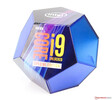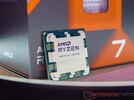Intel Core i9-9900KS vs AMD Ryzen 7 7800X3D vs Intel Core i9-9900K
Intel Core i9-9900KS
► remove from comparison
The Intel Core i9-9900KS is a high end desktop processor that includes 8 cores based on the Coffee Lake architecture. It is the fastest Coffee Lake CPU in 2019 and compared to the similar named i9-9900K, the KS offers an all core Turbo of 5 GHz. All cores can clock between 4 GHz and 5 GHz and thanks to Hyperthreading / SMT 16 threads can be executed in parallel. The CPU is still manufactured in the mature 14 nm process (14nm++). Thanks to the open multiplicator, the CPU is rather easy to overclock (if a Z390 based mainboard is used).
With good cooling, the i9-9900KS can be around 10% faster than the older Intel Core i9-9900K (thanks to the 5 GHz all core Turbo). Compare to the old Core i7-8700K, the 9900KS is even 45% faster. Especially for gaming, the 9900KS is currently the fastest option available. The fast Ryzen and Threadripper CPUs from AMD however offer a better multithreaded performance.
The integrated GPU is called Intel UHD Graphics 630 and clocks with up to 1.2 GHz. It is not suited for demanding 3D games and located in the low end.
The TDP is raised to 127 Watt for the additional performance, therefore a good CPU cooler is needed. When overclocking the CPU, more than 200 Watt can be reached unter load.
AMD Ryzen 7 7800X3D
► remove from comparison
The AMD Ryzen 7 7800X3D is a high-end desktop processor from the Raphael series with 8 Zen 4 cores and SMT (Simultaneous Multithreading), allowing it to handle up to 16 threads simultaneously. After its announcement in January 2023 at CES in Las Vegas, it was launched in April 2023. Following the launch of the two top models, the AMD Ryzen 9 7900X3D and the AMD Ryzen 9 7950X3D, the third model was introduced, which offers significantly more gaming performance with the 3D V-Cache.
The CPU cores have a base clock of 4.2 GHz and can be boosted up to 5 GHz (single-core turbo). The AMD Ryzen 7 7800X3D features a CCD with 8 cores, which includes the fast 3D V-Cache. This differs significantly from the two Ryzen 9 models, as they have two CCDs, but only one of them can utilize the 3D V-Cache.
The performance of the AMD Ryzen 7 7800X3D is consistently good, although its multi-threaded performance suffers a bit due to the eight native compute cores. However, the real strength of the AMD Ryzen 7 7800X3D lies in gaming performance, where it excels. In tests, we see consistently high gaming performance, even surpassing that of an Intel Core i9-13900K.
In terms of power consumption, the AMD Ryzen 7 7800X3D aligns with the other two models featuring 3D V-Cache, making the 8-core processor extremely power-efficient. In numbers, this means that the AMD Ryzen 7 7800X3D is specified with a TDP of up to 120 watts. The PPT (Package Power Tracking) is also rated up to 162 watts. For comparison, an AMD Ryzen 9 7950X is specified with 170 watts (TDP) or 230 watts (PPT).
Intel Core i9-9900K
► remove from comparisonThe Intel Core i9-9900K is a high end desktop processor based on the Coffee Lake architecture. At the time of announcement in late 2018, the 9900K is the fastest Coffee Lake CPU and offers an open multiplicator for easy overclocking. The CPU integrates 8 cores (16 threads) clocked at 3.6 - 5 GHz and it needs a new Z390 based mainboard.
Thanks to the two additional cores, the performance in multi-threaded applications is up to 25 % faster than the older Core i7-8700K. The single thread performance is only slightly faster due to the higher clock speeds. As a high end desktop CPU, the i9-9900K is suited even for very demanding applications and perfect for 3D gaming.
The integrated Intel UHD Graphics 630 graphics card is clocked at up to 1.2 GHz and offers no advantage compared to previous generations. As it is a very low end GPU, only some low demanding games like Hearthstone can be played with it (see GPU page for benchmarks).
Intel specifies the TDP at 95 Watt, so if the CPU is used in laptops a big and chunky cooling system is needed to avoid throttling and lower clock speeds under sustained loads. When overclocking the CPU, the power consumption can easily rise up to 200 Watt and higher.
| Model | Intel Core i9-9900KS | AMD Ryzen 7 7800X3D | Intel Core i9-9900K | ||||||||||||||||||||||||||||||||||||||||||||||||||||||||||||||||||||||||||||||||||||||||||||||||
| Codename | Coffee Lake-R | Raphael (Zen4) | Coffee Lake-R | ||||||||||||||||||||||||||||||||||||||||||||||||||||||||||||||||||||||||||||||||||||||||||||||||
| Series | Intel Coffee Lake | AMD Raphael (Zen 4, Ryzen 7000) | Intel Coffee Lake | ||||||||||||||||||||||||||||||||||||||||||||||||||||||||||||||||||||||||||||||||||||||||||||||||
| Series: Coffee Lake Coffee Lake-R |
|
|
| ||||||||||||||||||||||||||||||||||||||||||||||||||||||||||||||||||||||||||||||||||||||||||||||||
| Clock | 4000 - 5000 MHz | 4200 - 5000 MHz | 3600 - 5000 MHz | ||||||||||||||||||||||||||||||||||||||||||||||||||||||||||||||||||||||||||||||||||||||||||||||||
| L1 Cache | 512 KB | 512 KB | 512 KB | ||||||||||||||||||||||||||||||||||||||||||||||||||||||||||||||||||||||||||||||||||||||||||||||||
| L2 Cache | 2 MB | 8 MB | 2 MB | ||||||||||||||||||||||||||||||||||||||||||||||||||||||||||||||||||||||||||||||||||||||||||||||||
| L3 Cache | 16 MB | 96 MB | 16 MB | ||||||||||||||||||||||||||||||||||||||||||||||||||||||||||||||||||||||||||||||||||||||||||||||||
| Cores / Threads | 8 / 16 | 8 / 16 | 8 / 16 | ||||||||||||||||||||||||||||||||||||||||||||||||||||||||||||||||||||||||||||||||||||||||||||||||
| TDP | 127 Watt | 120 Watt | 95 Watt | ||||||||||||||||||||||||||||||||||||||||||||||||||||||||||||||||||||||||||||||||||||||||||||||||
| Technology | 14 nm | 5 nm | 14++ nm | ||||||||||||||||||||||||||||||||||||||||||||||||||||||||||||||||||||||||||||||||||||||||||||||||
| Die Size | 178 mm2 | 193 mm2 | 178 mm2 | ||||||||||||||||||||||||||||||||||||||||||||||||||||||||||||||||||||||||||||||||||||||||||||||||
| max. Temp. | 100 °C | 89 °C | 100 °C | ||||||||||||||||||||||||||||||||||||||||||||||||||||||||||||||||||||||||||||||||||||||||||||||||
| Socket | FCLGA1151 | AM5 (LGA 1718) | FCLGA1151 | ||||||||||||||||||||||||||||||||||||||||||||||||||||||||||||||||||||||||||||||||||||||||||||||||
| Features | Dual-Channel DDR4-2666 Memory Controller, HyperThreading, AVX, AVX2, AES-NI, TSX-NI, Quick Sync, Virtualization, vPro | MMX, SSE, SSE2, SSE3, SSSE3, SSE4.1, SSE4.2, SSE4A, x86-64, AMD-V, AES, AVX, AVX2, AVX512, BMI1, BMI2, F16C, FMA3, AMD64, EVP, AMD-V, SMAP, SMEP, SMT SHA, XFR2, Precision Boost 2 | Dual-Channel DDR4-2666 Memory Controller, HyperThreading, AVX, AVX2, AES-NI, TSX-NI, Quick Sync, Virtualization, vPro | ||||||||||||||||||||||||||||||||||||||||||||||||||||||||||||||||||||||||||||||||||||||||||||||||
| iGPU | Intel UHD Graphics 630 (350 - 1200 MHz) | AMD Radeon Graphics (Ryzen 7000) (400 - 2200 MHz) | Intel UHD Graphics 630 (350 - 1200 MHz) | ||||||||||||||||||||||||||||||||||||||||||||||||||||||||||||||||||||||||||||||||||||||||||||||||
| Architecture | x86 | x86 | x86 | ||||||||||||||||||||||||||||||||||||||||||||||||||||||||||||||||||||||||||||||||||||||||||||||||
| $513 U.S. | $449 U.S. | $488 U.S. | |||||||||||||||||||||||||||||||||||||||||||||||||||||||||||||||||||||||||||||||||||||||||||||||||
| Announced | |||||||||||||||||||||||||||||||||||||||||||||||||||||||||||||||||||||||||||||||||||||||||||||||||||
| Manufacturer | www.intel.de | www.intel.de | |||||||||||||||||||||||||||||||||||||||||||||||||||||||||||||||||||||||||||||||||||||||||||||||||
| TDP Turbo PL2 | 162 Watt | ||||||||||||||||||||||||||||||||||||||||||||||||||||||||||||||||||||||||||||||||||||||||||||||||||
| Transistors | 6570 Million | ||||||||||||||||||||||||||||||||||||||||||||||||||||||||||||||||||||||||||||||||||||||||||||||||||
| Voltage | 1.1 - 1.2 V |
Benchmarks
Average Benchmarks Intel Core i9-9900KS → 100% n=38
Average Benchmarks AMD Ryzen 7 7800X3D → 132% n=38
Average Benchmarks Intel Core i9-9900K → 95% n=38
* Smaller numbers mean a higher performance
1 This benchmark is not used for the average calculation












